Goal Zero is undoubtedly one of the reputable names in the solar energy industry.
The brand has been at the forefront of designing and manufacturing state-of-the-art solar appliances.
These appliances range from solar generators, battery packs, solar lighting equipment, and many others.
This article is a review and comparison of two of Goal Zero products, namely, the Yeti 200X and the Sherpa 100AC.
The two products are designed to fill in for your conventional source of electricity in case of power outages or other off-grid scenarios.
As their names suggest, both products are from different product lines, despite coming from the same brand.
Due to this, it is important to clarify the specifics of each model to reveal which one is the better overall option.
The Sherpa 100AC is better than the Yeti 200X because it is more versatile. The Sherpa is rectangular in shape and weighs two pounds. The Yeti 200X is square in shape and weighs five pounds. The Sherpa’s display screen has real-time port data. The 200X’s screen only shows battery charge status.
The Goal Zero Yeti Series
The Goal Zero Yeti line is a series of solar generators designed, manufactured, and assembled by Goal Zero. The series is one of the most diverse portable power station product lines available on the market today. The Yeti series ranges from the Yeti 150 up to the Yeti 6000X power station.
Each of the power stations in the series differs in output capacity and is ideal for different purposes.
This series is known for its durability, portability, and other impressive features.
The Goal Zero Sherpa Series
The Goal Zero Sherpa series is a lineup of power banks from Goal Zero. The series has three power banks ranging from the Sherpa 100 to the Sherpa 100PD and the Sherpa 100AC. The Sherpa 100PD and Sherpa 100AC are the successors of the Sherpa 100 power bank.
I have the Sherpa 100AC and below is an unboxing video showing the contents of the package.
The Sherpa 100AC has just under 95Wh of battery capacity, whereas the Yeti 200X has 187Wh. The difference in the size of the two systems is clear in the Yeti 200X image below.
Overview of the Goal Zero Yeti 200X

After reviewing the two series of products under Goal Zero, let’s narrow our comparison down to the power stations under review, starting with the Yeti 200X.
This portable power station is one of the lightest in the industry, and it is easily the lightest of the Yeti lineup. The 200X weighs only five pounds, which is less than half the weight of its predecessor, the Yeti 150, which used a lead-acid battery. While you won’t get a whole lot of electrical juice from the power station compared to its larger Yeti models, its output is enough to get your smaller devices charged and powered with ease.
There are numerous charging options with the 200X which means that you can recharge its battery in nearly any circumstance. Also, it offers multiple output ports for powering several devices at the same time. In all, the power station has many important features that make it one of the best lightweight portable power stations available on the market today.
Similar: Goal Zero Yeti 200x Solar Powered Generator
Goal Zero Sherpa 100AC Basic Overview
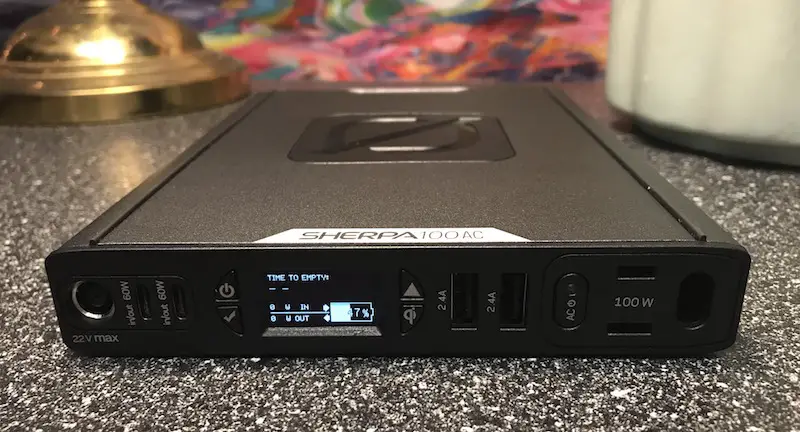
There is nothing as reassuring as having a power bank that can keep your devices up for long hours in the absence of electricity. This reassurance is what the Sherpa 100AC offers. The power bank has an incredible battery capacity for a power bank. It has a 25,600mAh battery which converts to about 94.7Wh.
This means you can use this power bank as a carry-on item for air travels, rather than go with bigger units that won’t be allowed on airplanes (the threshold according to the FAA is 100Wh for carry-on, rechargeable lithium batteries). The Sherpa 100AC comes with multiple ports for charging numerous gadgets at the same time. It also has multiple recharging options, meaning that you are not tied to a single charging method.
The term “power bank” may be a bit confusing when compared to the Yeti 200X, which is technically a “portable power station” or “solar generator”.
A power bank can be anywhere from 5,000mAh to 30,000mAh or larger in battery capacity. They are typically rectangular in shape and are only used to charge up small devices via USB connections. A solar generator typically has at least a 100Wh battery, but the majority of solar generators range from 500Wh to more than 5,000Wh. These systems can be charged via solar panels and will be able to power several different high-powered appliances and devices.
The Sherpa 100AC powers anything from smartphones to laptops and camera batteries.
In summary, the Sherpa 100AC is a powerful yet lightweight power bank that can keep your devices charged for long periods of time. The Sherpa 100AC is unique because it incorporates a single AC port within its output array. This is a very uncommon feature, as nearly all power banks have only USB or DC-capable outputs.
The most important features of these two systems are their batteries and input/output ports. In that regard, the specifications of both the Sherpa 100AC and Yeti 200X are listed below.
| Features | Goal Zero Yeti 200X | Goal Zero Sherpa 100AC |
|---|---|---|
| Battery Capacity | 187Wh | 94.72Wh |
| Battery Type | Lithium-ion | Lithium-ion |
| Weight | 5 lbs | 2 lbs |
| Number of Input Ports | 1 (8mm) | 3 (8mm, 2x USB-C PD) |
| Number of Outputs | 7 | 6 |
Despite being two different products (portable power station and power bank), both perform the same function – powering gadgets and appliances. Therefore, the comparison will be based on the following features:
- Battery Capacity and Output Power
- Size and Weight
- Battery Type
- Charging Mechanisms and Duration
- Output Ports
Battery Capacity & Output Power – Yeti 200X vs Sherpa 100AC
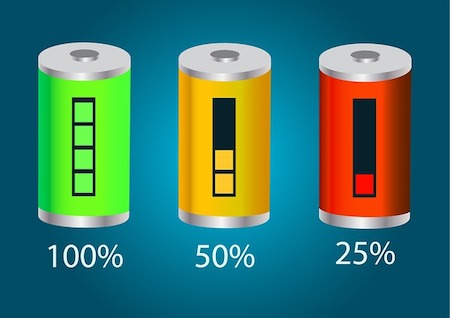
The battery within any portable power station or power bank is its most important feature. It determines the number of gadgets and devices that you can power with it. It also influences how long you can power the gadgets for.
Yeti 200X – Battery Capacity
The Yeti 200X’s battery capacity is 187Wh. Compared to the other Yeti X-series solar generators from Goal Zero, this is by far the smallest battery size. The next model in the Yeti X-series is the Yeti 500X, which has a 505Wh battery. However, the 200X serves the purposes of powering small devices and gadgets and its battery size does this with ease.
This amount of electrical power comes from its lithium-ion battery. Combined with its USB ports, 12V ports, and AC inverter (120W continuous, 200W surge), the 200X doles out enough power to charge electronics like phones, laptops, and camera batteries with ease.
Yeti 200X – Output Power
The 200X will charge the following devices with one fully charged battery. Please note that one fully charged Yeti 200X battery will use all of its battery power for each individual item. For example, it will recharge a smartphone 16 times before running out of battery.
- POV Camera (5Wh): 38 full recharges
- Smartphones (12Wh): 16 full recharges
- Tablet (30Wh): 6 full recharges
- Laptop (50Wh): 4 full recharges
Other appliances that the Yeti 200X can power include a 25W portable fridge for eight hours and a 4.5W light for 42 hours.
Sherpa 100AC – Battery Capacity
The Sherpa 100AC possesses a 94.72Wh battery capacity. This is equal to 25,600mAh, as power banks tend to measure their batteries in the “mAh” format. Like the 200X, the 100AC also utilizes a lithium-ion battery.
This is nearly exactly half of the 200X’s battery capacity, making the 100AC less capable but lighter in overall weight.
Sherpa 100AC – Output Power
Since the Sherpa’s battery is about half that of the Yeti 200X, its recharging capability follows suit.
- POV camera (5Wh): 19 full recharges
- Smartphone (12Wh): 8 full recharges
- Tablet (30Wh): 3 full recharges
- Laptop (50Wh): 2 full recharges
The instances given above shows that the Sherpa 100AC is a reliable power bank that can stand tall when it comes to battery capacity and electrical power output.
Verdict – Battery Capacity & Output
While both the Yeti 200X and the Sherpa 100AC have impressive power output and battery capacities, the Yeti 200X has longer-lasting overall power output. With a capacity of 187Wh, the 200X’s total output far surpasses that of the 100AC’s 94.72Wh capacity.
This means that the Yeti 200X can power your smartphone and other gadgets for a longer period than the Sherpa 100AC, making it more reliable in off-grid situations.
Size and Weight of the Yeti 200X & Sherpa 100AC
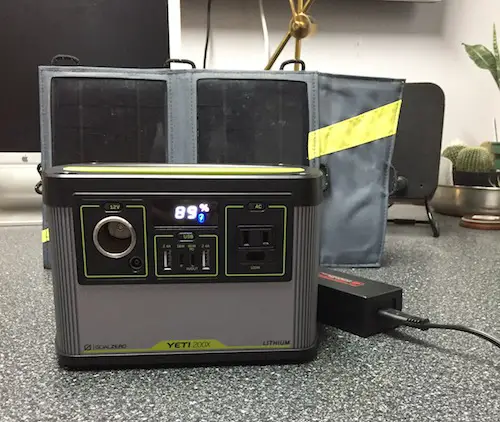
When the power goes out at home, portability is not a huge concern with solar generators and power banks as the battery doesn’t need to be moved long distances to be accessible.
Size and weight are important to know when using these systems while on the go. As a result of on-the-go needs, the solar generators/power banks must be light, portable, and very easy to carry.
One main downside of these electrical systems is that they are not waterproof. They must be used with care when in rainy or wet conditions outdoors.
The other important fact to consider is each system’s operating temperature. Both the Yeti 200X and Sherpa 100AC have operating temperatures of 32-104 degrees Fahrenheit. Going beyond this temperature threshold puts the battery at risk of not operating at all and/or a significant reduction in the overall cycle life of the battery.
Dimensions and Weight of the Yeti 200X
The Yeti 200X weighs a total of five pounds, which translates to about 2.3 kilograms. This is a lightweight solar generator. It is the lightest of Goal Zero’s entire Yeti lineup.
Coupled with its dimensional size, which measures 8 by 5 by 5 inches, the power station is both lightweight and portable. It is easy to carry and is suitable for use in almost all locations.
The 200X has a carrying handle on top of it, which makes it a bit more versatile if you want to carry it instead of storing it in a backpack.
With a 5-inch width, the 200X is one of the most compact solar generators you can buy. However, even at this width, it will be bulky when placed in a small backpack for hikes.
Dimensions and Weight of the Sherpa 100AC
The Sherpa 100AC weighs only two pounds and measures 7.5 by 1.0 by 5.7 inches in size. This means that it is 2.5 times lighter than the Yeti 200X. Not only is it lighter, but its overall volume is more than one-fourth that of the Yeti 200X.
This is important for people looking for a lightweight battery to have while backpacking. You can simply carry it in your backpack without worrying about the size.
Verdict – Size & Weight
The Sherpa 100AC comes out on top when comparing the portability of the two battery-powered systems. Not only can it easily be used at home when the power goes out, but it can also be a valuable tool when traveling off the grid.
Similar: Top 5 Solar Generators for the Apartment (Small to Large)
Battery Types Within the Yeti 200X and Sherpa 100AC

There are different types of batteries used in portable power stations, but nearly all power banks use lithium-ion batteries.
The popular battery types used for portable power stations in the industry include LiFePO4, Lithium-ion, and the lead-acid battery type.
Both the Yeti 200X and the Sherpa 100AC use the lithium-ion battery type. This battery type is one of the best types in the industry due to its high energy density and low discharge rate. Only the LiFePO4 is superior to this battery type in terms of quality and longevity.
As a result, both products have an impressive number of battery lifecycles for their size. For the Yeti 200X, the battery cycle life is 500 cycles to 80% efficiency. The Sherpa 100AC is rated for “hundreds of cycles” within its user guide (page 15).
Apart from the same battery type, both of the power stations use battery protection systems. The Yeti 200X uses PWM charging technology and has a low battery protection system. The Sherpa 100AC has charge protection and a low battery protection system.
Verdict – Battery Type
Both of the products under review use the same type of battery and very similar battery protection systems. This means that both batteries have impressive lifecycles, efficiency, and durability. However, the Yeti 200X has a longer cycle life than the Sherpa 100AC with its 500 cycles to 80% capacity.
Yeti 200X vs Sherpa 100AC – Charging Duration and Mechanism
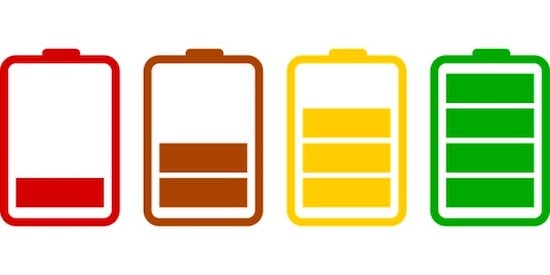
Portable power stations and battery banks do not produce electricity. They store the electricity produced from different sources. The process of storing electricity in these systems’ batteries is simply known as charging or recharging.
From its definition, it is clear that charging is an important feature of both of these products as it affects its ability to adequately power any gadget or device. Therefore, it is important to consider the charging methods available for the power stations under review.
Charging the Yeti 200X
There are three major charging options for the 200X. They include charging from the wall, from solar panels, and from the car. The wall charging method involves the use of a 60W power supply cable, which charges the Yeti 200X in four hours. Should you want to reduce this duration to half, you can use the Yeti X 120W Power Supply.
The solar charging option allows for various sizes of solar panels to be used with the 200X. The capacity of the solar panel(s) determines the charging duration.
For instance, it takes 11-22 hours to fully charge the Yeti 200X when using the Nomad 20 solar panel. The Nomad 50 and Boulder 50 each take about 4-8 hours to charge the power station. The Nomad 100 solar panel takes about 2-4 hours to fully charge the 200X.
Finally, the car charging option involves plugging the power station into the 12V outlet of your car. The cable designated for this purpose is the Yeti Lithium 12V Car Charging Cable. The usage of another cable for car charging is dangerous and can damage the solar generator.
Charging the Sherpa 100AC
The Sherpa 100AC equally has the same three charging options: solar, wall, and car charging.
The Goal Zero Sherpa 45W wall charger completes the recharging process in three hours. The wall charger is not included with the Sherpa 100AC or 100PD power banks. It has a USB-C output (45W max) and a USB-A output (12W max).
The duration for the solar charging options, in this case, also depends on the size of the solar panels. For instance, the Nomad 20 charges the 100AC in 7.5-15 hours. The Nomad 50 and Boulder 50 will take 3-6 hours to charge the Sherpa up.
You can also use the 60W USB-C PD cable to complete the charge in 2.5 hours. However, the use of a USB type-A charging cable extends the charging duration to about nine hours.
Lastly, the car charging option takes three hours to complete the full recharging of the Sherpa.
Verdict – Charging Duration & Mechanism
Both of the products under review have the same charging options. While the Sherpa 100AC charging durations are shorter than that of the Yeti 200X, the longer charging duration of the Yeti 200X can easily be attributed to its higher battery capacity.
Output Ports – Yeti 200X vs Sherpa 100AC
One of the features of an impressive portable power station or power bank is its ability to charge numerous gadgets simultaneously. The higher the number of ports, the more gadgets you can charge at the same time.
Port Options on the Yeti 200X
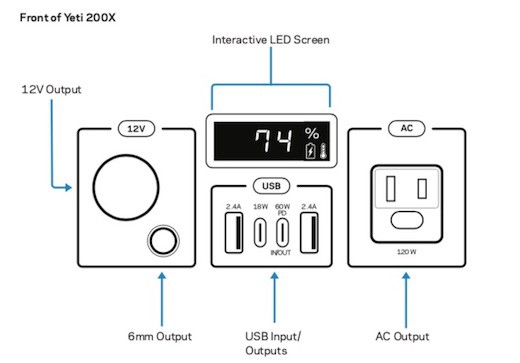
To start with, the Yeti 200X has seven output ports. These ports include:
- 2x USB-A ports (12W max per port)
- 1x USB-C port (18W max)
- 1x USB-C PD port (60W max)
- 1x 6mm charging port (120W max)
- 1x 12V car charging port (120W max)
- 1x AC port (120W continuous, 200W surge)
Port Options on the Sherpa 100AC

For the Sherpa 100AC, there are six different output ports. These include:
- 1x wireless Qi pad (5W max)
- 2x USB-A ports (12W max)
- 2x USB-C PD ports (60W max)
- 1x AC port (100W max)
Verdict – Output Ports
The verdict is a draw in this comparison. Although the Yeti 200X wins in terms of total port options, the Sherpa 100AC offers a wireless charging port and a second USB-C PD port, both of which are absent in the Yeti 200X.
Conclusion
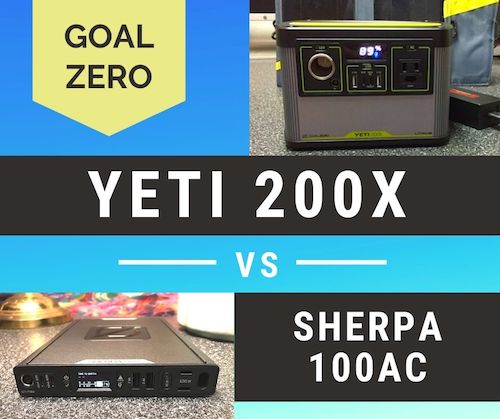
After comparing the two power stations, the Sherpa 100AC is the better overall battery solution. The Sherpa can be used in various off-grid scenarios, including backup power when there’s a blackout at home, as well as backpacking and camping.
The Yeti 200X has the capability to do the same as the Sherpa 100AC, however, it is less likely that someone will use the 200X in a backpacking scenario due to its square shape. The size of the Sherpa makes it much more versatile to use, as it is only one inch thick.
The 200X has twice the battery capacity of the 100AC, so it is better to use it at home when it is in one place.
Find the Sherpa 100AC here on amazon.com. This is an affiliate link, where I make a small commission on every sale.
Continue Reading:
Bluetti AC200 vs AC200P – Key Differences & Takeaways
Can a Solar Generator Run a Furnace? (Furnace + Generator Examples)
What Size Portable Solar Panel Do You Need? (Detailed Overview)
